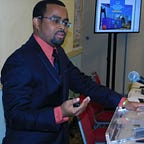Re-engineering Impromptu Speaking🤓
The results and conclusion…
As a professional engineer, nothing speaks more truth to me than numbers. So imagine my joy when the “wrap-up” survey completed by participants of my high performance leadership project called “On-the-spot”, revealed improvement in the confidence levels of all the participants (in their impromptu speaking). I was like…
If you are just joining us, you can read a summary and design of the project HERE. As you can see from the graph above however, at the start of the project, ‘participant #1’ (the survey was done anonymously to protect their privacy) had self-assessed his/her self as being at a “1” in confidence level(on a scale of 1 to 5). With a “5” as being extremely confident, this participant left the program at a whopping “4” on the scale. Several other participants revealed improvements at various levels as well, and reporting varying levels of involvement/engagement. Was this random? Or was there some correlation?
Predictability
While assessing the survey results, I realized finding a pattern in the results would confirm two main things. First, would be that I was way too in love with numbers and data 🙄, and the second being more significant… Finding a pattern would mean that if anyone repeated this project as prescribed, they could scientifically predict the improvement levels of all their participants simply by the knowing the aspects of the project that they would be involved in. A project with a guaranteed outcome! And so said…
…So done. It was repeatably seen, without exception, that where participants had participated in 2 or less events in the program, there would be improvement…but by just one level increase in confidence(still good!).
If a participant wished to improve by 2 levels, the graph’s prediction showed that he/she would have to participate in a minimum 3 of the program’s events. Then, in order to achieve an improvement greater than 2 levels, all four events needed to be engaged in. This was no longer a regurgitated cliche or just gut instinct. DTM Godfrey (see blog #4) and all my mentors had been right all along- no matter how hard it initially seems….
“PRACTICE MAKES PERFECT”
The activity/event that appeared to have the most correlation to improvement in confidence level, was the Table Topic Tours (see blog #6). So would we have had the same results had we just jumped straight into the TT tour-athons? I doubt,… my own experience was that each step played an important role in building the ‘muscles’ needed.
Feedback from participants
But it wasn’t just numbers. The OTS peeps also voiced what worked for them during the program as well. It was important to know the psychological prompts to these improvements as well, since “practice, practice, practice” was not actually a new concept to any of us. What made the difference? The most frequently mentioned aspects that participants said influenced a change were:
“Evaluations of my speeches, coaching and receiving my video clip(s)”
“All aspects of the OTS program”
“DTM Godfrey’s presentation and shared experiences”
When asked what was least useful in the project, the majority of participants (without prompt) stated no improvements were necessary, highlighting that all aspects were relevant and impactful. A few of the OTS crew did, however, offer potential improvement points:
“More sessions with the [private] group”
“A longer program, or have this OTS program repeated annually”
“More advice from persons who have overcome the specific issues we were facing”
Conclusion and Closeout
The vision of “On-The-Spot” was achieved and exceeded. Today, the OTS group is not just alive, but growing in numbers; and still continuing to volunteer for impromptu speaking practice at other Toastmaster Clubs.
I would like to thank all the members of the team(s) who made this maiden voyage of On-The-Spot possible. I speak of my guidance committee (Carol Riley and mentor Corren Thomas), the OTS speech evaluators, my guest speaker (Godfrey McAllister), my Table Topic Masters, and event Timers. And of course special thanks to the PARTICIPANTS; the persons who showed, (scientifically!) that being bold, does in fact give a measurable and tangible outcome.
It would be remiss of me not to thank YOU, my readers, for following along with us on this exciting journey, living vicariously through the team. Here ends my report on the OTS project…but Am I done with blogging???. I think not!!!
Click “Follow” to ensure you are informed once my upcoming articles/blogs (on other topics/issues) are released. And for those interested in learning more about how Toastmasters can improve your confidence level in public speaking and leadership, and/or wish to visit a toastmasters club online (it’s FREE!) you may email us at secretary.dynamicspeakersja@gmail.com. See you soon!
Click HERE to see blog #7 (previous blog in this series)
